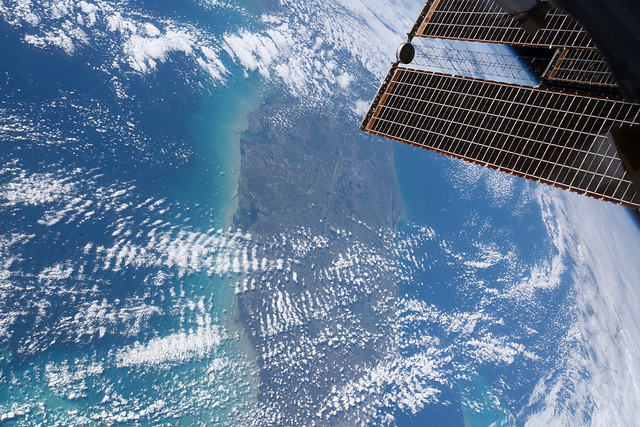
May is graduation month, and with it, school star party season is about to conclude. If you happen to be out this coming weekend showing the sky off to the public, keep an eye out for one of the top celestial sights that you won’t see at the eyepiece, as we’re in for a slew of good visible passes of the International Space Station worldwide.
Welcome to the start of what NASA refers to as “high beta angle season,” a time when the station enters a period of full illumination throughout the span of its orbit. This fortuitous circumstance is a direct result of the station’s orbit, inclined 51.6 degrees relative to the Earth’s equator. The station was deliberately placed in this orbit in order to make it accessible to international partners worldwide. This also makes the station visible to over 99 percent of humanity, from latitude 60 degrees north to 60 degrees south.
Full illumination for the ISS occurs near each solstice, with June favoring the northern hemisphere for multiple bright passes every evening and December favoring the southern. This week, the International Space Station exits the Earth’s shadow on May 17th at 18:42 Universal Time (UT)/2;42 PM EDT, and doesn’t hit the Earth’s shadow until briefly on May 20th at 17:55 UT/1:55 PM EDT. Passes over central Asia also favor seeing another unique event: seeing the ISS enter, then exit the Earth’s shadow on the same pass.
This is also about as early as high beta angle season can occur, over one month prior to the June 21st solstice. On this date, the north rotational pole of the Earth is tipped its farthest towards the Sun, and the station’s orbit along with it. Viewers in the United Kingdom, southern Canada and the northern United States along latitude 45 to 55 degrees north can expect to see multiple illuminated passes of the International Space Station in one night.
A friend of ours (@OzoneVibe on Twitter) has suggested that this phenomenon be known as a FISSION, for Four/Five International Space Station passes in One Night. Can you complete a FISSION in one all-night marathon session?
High Beta Angle season is a special time for NASA and the station, as well. During this period NASA generally ‘feathers’ the station’s huge solar panels, in order to create artificial shadow and avoid overheating key areas. Most exterior operations, such as scheduled extravehicular activities (EVAs) and arrivals and departures from the station are avoided if possible around this time as well.
When’s the next ISS pass near you? A multitude of apps and websites exist to track the station and other satellites; our favorite go to is the old standby, Heavens-Above. Moving at 17,100 mph (27,600 kph) and orbiting at an average of 250 miles (400 kilometers) above the Earth’s surface, it takes the station just over 92 minutes to orbit the Earth.
Observing the station is as simple as watching at the appointed time and waiting. The station will appear as a bright moving ‘star’. Unlike aircraft, the station shines by reflected sunlight and won’t blink, though it may flare up in brightness as the Sun glints off of a solar panel. The station can reach a brilliant magnitude -5.7 when it passes near the zenith, bright enough to cast a shadow. At 108.5-meters across, the International Space Station is the largest object in orbit ever constructed. You can even see structure in binoculars on a good pass. Depending how the station is oriented, it can look like anything from a miniature Star Wars TIE fighter, to a tiny box, to a flattened double star on a good pass.
You can also image the station by simply running a wide-field time exposure during a pass, and letting the ISS trail through the field. More challenging is to image the space station through a telescope. Several dedicated backyard observers employ sophisticated tracking and fine-guiding programs to image the ISS. We’ve gotten acceptable results by simply running video during a pass, roughly aiming the ‘scope and tracking the ISS, and seeing what turns up afterwards. Be sure to preset your focus and exposure time before the pass starts. A bright planet, star or passing aircraft make great targets to practice on beforehand.
Another technique is to aim at the Sun or Moon, and wait for the ISS to come to you. CALSky and Transit Finder are great resources to let you know when the next transit of the ISS across the Sun or Moon is occurring near you. These events are quick (often less than a second in duration) and often involve a bit of travel to get positioned at the precise location we’re they’ll occur.
Currently, there’s a full crew compliment of six humans aboard the ISS: three NASA astronauts, two Russian cosmonauts and one Canadian astronaut. The station has been continuously occupied since November 2nd, 2000. That’s right: we pass the 20 year mark for continuous human presence in space, late next year. A marvelous achievement worth noting as you watch the ISS pass overhead this weekend.
